
Original Link: https://www.anandtech.com/show/889
CeBIT 2002 Part 1 - A/V Devices & More
by Tillmann Steinbrecher on March 18, 2002 12:00 PM EST- Posted in
- Trade Shows
Last week, the world's largest computer fair opened its doors -
CeBIT 2002 in Hannover.
AnandTech's CeBIT news coverage consists of two parts - one about the audio
and video sector (music and video players, and a quick glance at PDA technology)
and one about PC technology: chipsets, motherboards, graphics cards, and cooling.
Audio and video certainly is not the main focus of CeBIT - nevertheless, a few
interesting products were shown in this area; in particular hard drive based
audio recorders and hardware for MPEG4 playback.
Sony enters the MP3 CD player market
Until now, MP3 players came from companies that have their roots in the PC
market, like SonicBlue. There has only been one exception to this - the Philips
Expanium. The most likely reason for this is that the major audio players feared
the pressure of the music industry. Considering this, it is quite amazing that
Sony - which is sells records itself - presented two MP3 CD players at CeBIT.
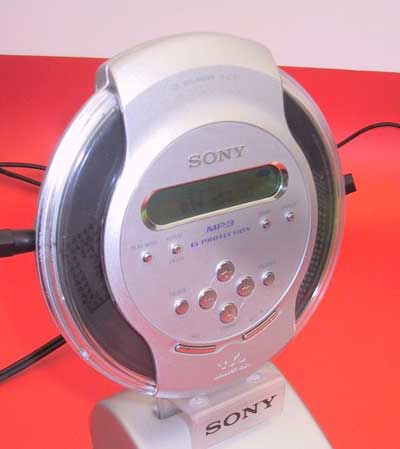
The player shown here is the high end model, which will be more expensive
than most current portable MP3 CD players. Here's a closeup of the display:

The player looks quite elegant and is sleeker than the RioVolt. However, one question remains - how can comfortable navigation on the CD be realized with just a two-line text display?
A lower-end model, with a price range similar to the RioVolt, will also be available.
Hard drive based audio recorders
In addition to the MP3 players and the new "NetMD" minidisc units,
Sony also presented a hard drive-based audio recorder. This unit comes
in a very stylish case and is equiped with a 40 GB hard drive.
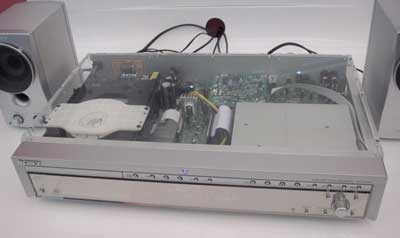
This unit, however, uses ATRAC3 for audio compression. The default
bitrate for encoding is 132kbit/s; copying from the CD to the HD
is done at 2x speed. The unit is compatible with copy-protected
CDs (e.g. Cactus Data Shield).
It cannot even play MP3s, and what's worse: it cannot
read CD-R or CD-RW media at all. You can't even play the music you
recorded yourself on a burnt audio CD on it! The player has an USB
interface, but it can only be used for controlling it from the PC
- music transfer to and from the PC is not possible. The unit doesn't
even feature an SP/DIF out put - a feature that is standard now
even on low-end CD players.
The recorder has a two-line text-only display, which is behind a
mirror-like surface; it looks cool, but is a little hard to read
under certain lighting conditions.
It is obvious that this recorder is designed with the interest of
the music industry in mind (and that includes Sony itself), and
not to meet the wishes of the potential customers.
The price for this unit will be $880 at the time of writing of this
article. The big question is: Who is going to buy this? PC enthusiasts
are certainly going to avoid it because of the lack CD-R and MP3-support,
and the inability to exchange files using the PC. And audiophile
HiFi-enthusiasts probably won't buy it either, because of its low
bitrate encoding.
A much, much more interesting hard drive based audio recorder was
presented from a company that isn't quite as well-know as Sony:
Terratec.
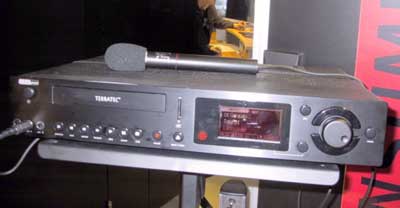
Just like the Sony unit, it features a 40GB hard drive - but
this is where the similarities end. The Terratec unit uses the
Fraunhofer MP3 codec for compression; MP3 encoding at bitrates
from 64K to 320K CBR are supported. The recorder has an easy-to-use
and easy-to-read graphical interface; navigation is done using
the jog-dial on the right.
The recorder has some interesting features for coping with the
large amount of music titles stored on it. You can define and
combine rules based on ID3 tag information - e.g. you can tell
the unit something like "show all Jazz from 1970 to 1975".
Using the USB port, it is possible to control the unit from
the PC, and exchange files in both directions. CD title recognition
is done using the "Gracenote" database, which is installed locally
on the HD, and can be updated via PC or CD. The recorder has
all relevant in- and outputs, including SP/DIF in and out.
As for the technical details: The recorder uses an ARM processor,
and runs a proprietary operating system. No info on the DAC
chips used or the specs of the analog part of the unit were
supplied. But even in the case that the analog output isn't
great (which we don't know yet - with the small speakers and
the background noise on the Terratec stand it was impossible
to judge the sound quality), it is possible to use the unit
with an external DAC or use a DAT or Minidisc recorder for the
digital/analog conversion, since the Terratec recorder features
an SP/DIF output. This, together with the possibility of using
a high encoding bitrate, should make this recorder interesting
even for very audiophile Hifi users.
While all this sounds good, the unit isn't flawless. First of
all, it can only copy CDs at 1x speed. And second, it does not
support copy-protected CDs. The reason for this is not technical,
but legal: with laws made to defend the interests of the music
industry in Europe, bypassing even the most simple copy protection
is illegal.
The price of the Terratec recorder is identical to the Sony's,
$880.
Going MPEG4
When it comes to video on portable devices, MPEG4 is the thing of the future - the products presented on CeBIT proved this. A very interesting product was shown by a little known company called Archos: A portable MPEG4 video player with integrated 10GB HD.
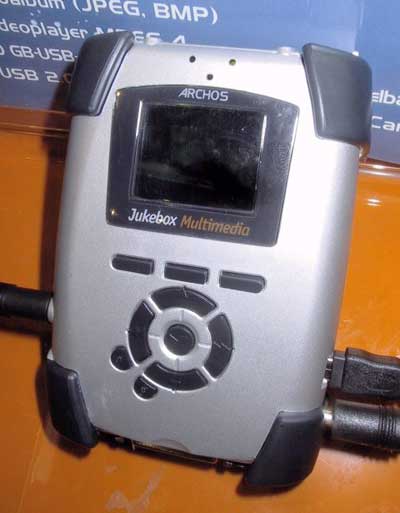
Detailed specs can be found
here on Archos' website. The Jukebox Multimedia's display
isn't that great (very angle-dependant); however Archos had
a TV connected to it - and the quality of the TV out is amazing.
There were no visible compression artefacts, and the image
was very crisp. When paying very much attention, one could
however notice that the playback sometimes wasn't perfectly
smooth. In addition to MPEG4 video, the Jukebox can also play
MP3, and display JPEG and BMP images. In addition, it acts
as an external USB hard drive.
The question many of you will be asking now is: Does it play
DivX? Archos couldn't answer this question; the only info
provided was that it plays MPEG4 in CIF format - 352x288 pixels.
Our guess is that it won't play DivX 3.X content; however
it might be possible to encode video using DivX 5 and/or DivX
4 in a way that it is compatible with the Jukebox. This remains
to be seen once the unit makes it on the desks of the reviewers.
The Jukebox Multimedia should be available already in April.
Let's just hope that it will really appear on the market,
and that the MPAA or similar organizations won't find a way
to put legal or financial pressure on Archos. According to
Archos, this has not happened yet, but they indeed fear it.
MPEG4 for the PDA
As we've already recently seen at IDF, ASUS has made their intentions clear for entering the PDA market. At CeBIT they presented a couple of Windows-based PDAs. The interesting thing about the PDA shown here is that it features video playback in great quality.
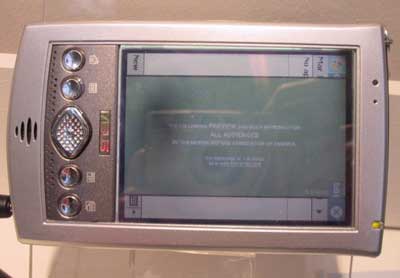
Note that the dark area on the left side of
the display is not a fault of the PDA, but some dust on
our camera's lens. The display is very sharp and bright.
It is likely that in the future, we'll see more PDAs with
video playback features, and even 3D features - a very interesting
3D/video core for PDAs is coming up as you're about to see...
Imagination Technologies PowerVR MBX - 3D and MPEG4 for the PDA
PowerVR Technologies, a division of Imagination Technologies, demonstrated their PowerVR MBX technology, a complete 2D/3D graphics solution for PDAs and similar devices, like future multimedia mobile phones. This was not shown to the public, but presented in a backroom of the booth.
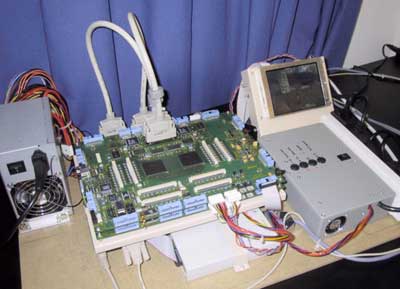
Contrary to what has been reported, Imagination did not
present an actual prototype of the chip; instead, they showed the chip design
running on a generic FPGA from Xilinx (FPGA stands for Field Programmable Gate
Array - think of it as a generic chip that can be configured by software to
emulate a chip design). On the FPGA, the PowerVR MBX ran at only a little over
10% of the speed of the final product - 14MHz as opposed to 120MHz for the final
product. Even at this low speed, the performance was quite amazing - it reached
the level of a Playstation One.
The demo system shown above was running Linux on an ARM 920 processor. Imagination
ported the TombRaider engine (based on the source code for TR for PS 1) and
showed it running on the 320x240 pixel LCD:
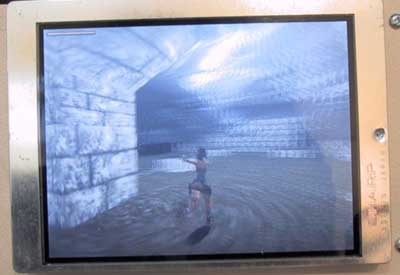
Unfortunately the demo could not be paused, this is why the photo looks a bit strange - but you can believe us, it does look great when you see it in person.
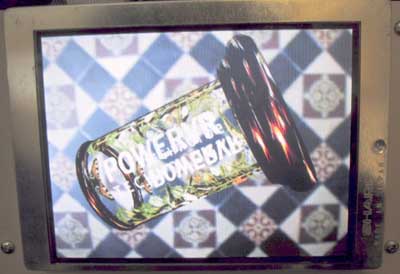
Here's another photo of the display, while running a 3D demo.
The chip supports all features of a modern graphics chip, including FSAA (antialiasing).
A companion vertex geometry processor is also available for T&L operations.
The PowerVR MBX will also have features for video playback acceleration. Using
the PowerVR MBX, MPEG4 playback will be possible. Again, the question many of
you are probably wondering about is: Does it play DivX? PowerVR Technologies
will only support "true" MPEG4; however, they said that since DivX is so similar
to MPEG4, the chip should also be able to play that - provided that someone
else writes the software for that. This is not totally unlikely - remember,
the demo system ran Linux, and if PowerVR makes the specs available to the public,
then it should only be a matter of time until the Open Source community does
something about it.
PowerVR/Imagination will not manufacture or sell PowerVR MBX chips; they license
their technology so that it can be integrated into chips of other manufacturers.
The PowerVR MBX is suitable for integration with ARM cores. It should be available
in late 2003.
A HDD/DVD player from LG
LG showed a HDD/DVD player on CeBIT, in a very stylish case:
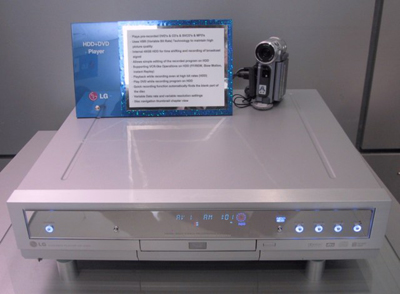
It plays pre-recorded DVDs, SVCDs, CDs and MP3s. The size of the internal HDD is 40GB. The player supports time shifting (meaning you can start watching a movie while the end of it is still being recorded), and you can even play DVDs while recording something else. For recording, VBR (Variable Bitrate) technology is being used. Simple editing of the recorded program on the HDD, as well as typical VCR functions like fast forward/rewind, slow motion, etc. are also supported.
A DAB (Digital Audio Broadcast) tuner from VideoLogic
VideoLogic also presented their DAB tuner on CeBIT. DAB is a new standard for high quality digital radio broadcast, which will replace FM radio in the long term.








